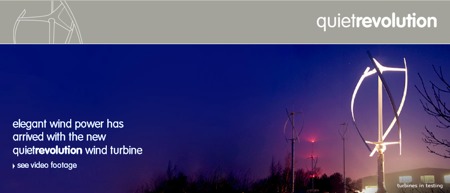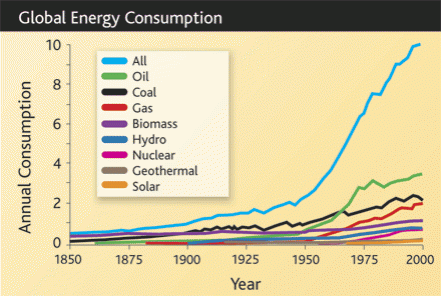
|
||
|
|
||
|
09 02
New Wind Turbine Designs
When you think of a wind turbine do you think of a oversized propellor on a tall stick? You are not alone. The world is being slowly land-marked by thousands of these wind power icons. There are alternative though, especially when thinking about smaller, lower powered turbines in urban settings. One unique design is the Quiet Revolution “elegant” turbines. Shaped more like a blender blade and less like a fan, the QR5 design brings a number of advantages to the world of green power generation.
08 12
Comparing Responses To Oil Crisis
In August 9th’s New York TImes Thomas L. Friedman author of “The World Is Flat” writes about how Denmark faced down the last oil crisis. He then compares how the U.S. responded (and, by extension, how Canada is now responding). Big difference.
Friedman goes on to argue that regulatory intervention spawned innovation in Denmark not seen in the United States. How does he measure it?
For more about the Danish wind power industry, please go here.
08 05
The Environmental Macroeconomics Of Predicting The Future
There was a time when predicting the future was best left to charlatans and religious leaders. Few legitimate academics, if any, were willing to bet their careers on some pie-eyed prognostications on what might be happening globally in, say, 2050. Unfortunately, guessing what might happen fifty years from now is easier than ever, with more and more respected literati lining up to take a shot at it. Why? Well, the world of economic theory has made predicting the future child’s play if you know the rules. Take, for instance, the world’s energy consumption. Were you aware that the world consumed some 13.5 terawatts of energy from all sources in 2002. BTW, a terawatt equals one trillion watts. That could power a lot of electric cars. The United States was by far the greatest consumer of that power. MIT professor Daniel Nocera calculated that if the world’s population is 9 billion people in 2050, and they consumed electricity like Americans do today, the world would need to produce 102 TWs of power, a staggering amount that could not be supplied with current technologies. (Read the story here) Economics suggests that in a supply and demand world people and governments will respond to this growth in one way. They will produce more energy. So how will they do it? Given the trend towards more and more energy use as the former third world continues its move to first world standards, possible scenarios get filtered out as being either unsustainable or ridiculous. The truth of 2050 is binary. Either we will have figured out how to produce adequate amounts of power in sustainable ways or we will live in a world that is apocalyptic—at best. The future’s big hope? Solar energy.
08 01
CKF Film Friday No. 7: How Some Media Spin Green
We all know that in an open society voices from a range of the political spectrum have the right to state their views. In recent years media purveyors have built empires around an extension of this concept: There is no longer truth, there is only opinion. One of the most successful empires built on this strategy is Rupert Murdoch’s Fox News. So, when Al Gore releases “An Inconvenient Truth” it is no surprise that Fox takes a different position. After all, when there is no truth what remains is only ad revenue. Here are some egregious examples of how media influences the masses around green issues.
07 18
CKF Film Friday No. 6: Al Gore Predicts The Future
In case you didn’t watch or hear about Al Gore’s challenge to citizens of the Untied States yesterday, our film Friday brings it to you in its entirety. What is Gore’s challenge? He wants the U.S. to generate all its electricity from carbon-free sources by 2020. Quite a challenge, but achievable through existing technologies now that oil is over $50 a barrel. Will his desired audience listen? If the comments on YouTube—where the video is posted—are an indication, we are at about 50/50 yes and no.
Here are some of my favourites:
This person’s answer is to invade Cuba and piss off the Chinese—not very good strategy for a host of rather obvious reasons.
Another was more thoughtful, even startling, but their conclusion takes a nasty turn for Gore:
Then there are the inevitable arguments over the validity of global warming:
My favourite piece of paranoia makes references to the movie “There Will Be Blood’s” long straw metaphor:
If you follow this person’s line of thought the Chines will soon be beating the U.S. over the head with a bowling pin. Enough of the commentary: here is the Nobel Prize winner speaking for himself. Enjoy.
07 11
New York TImes: American Energy Policy Asleep At Spigot
Nelson Schwartz of the New York TImes takes aim at America’s glutinous consumer class and the country’s politicians in a critique of the country’s energy policy.:
While everybody knew that the 8 cylinder, gas-guzzling proclivity of the buying public was just not sustainable, turning off all that profit was not going to happen. Instead auto companies and their government enablers poured billions into a model that was never going to bring the North American auto industry the competitive success it wanted.
07 02
Why You Should Care About Your CO2 Emissions
If you are a polar bear or a penguin, the news so far this year is not good. First, this summer may be the first time in recorded history that the Arctic’s polar ice cap melts. Not concerned about something so far away from your downtown condo? Don’t be too smug. These kinds of environmental changes will impact you no matter where you may live—you drink water, don’t you? Watch this video and you may be convinced high gas prices are a good thing if they keep another Hummer off the road.
Then there is the Antarctic. In a recent academic study from Australia, researchers speculate that a massive rise in the oceans’ water levels could be just a few years away:
Opdyke goes on to say that such a collapse could take place in weeks rather than decades. Now, aren’t you glad you support the local Sierra Club and your family has reduced its carbon emissions? What about your business? Is it part of the old economy—you know, the one that measures success by the amount of polar ice it melts—or is it embracing the future of green? |

Contribute to the MESH Cities intelligent city database. Click here.
Read what people are saying about the environmental issues that impact us all
News about wind energy
News about green investing
Blog posts about electric cars
|
The best green news sources on the Net
Treehugger
Eco Worrier
Inhabitat
Lime
World Changing
|



